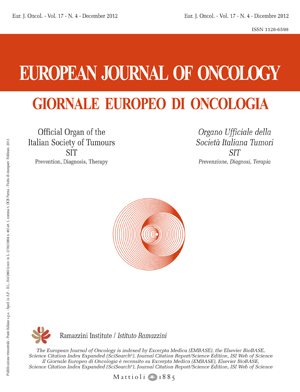Salivary glands/Ghiandole salivari (C08.9) - Survival from major salivary gland cancer in a Spanish population: follow-up of patients diagnosed between 1978 and 2002 / Sopravvivenza al cancro delle ghiandole salivari maggiori in una popolazione spagnola: follow-up di pazienti diagnosticati dal 1978 al 2002
Keywords:
Salivary gland neoplasms, survival, Spain, Tumori delle ghiandole salivari, sopravvivenza, SpagnaAbstract
Aim. This article aims at studying major salivary gland cancer survival from the Population-Based Cancer Registry of Zaragoza, Spain, for the period 1978-2002. Materials and Methods. The survival rates were calculated by the Kaplan- Meier method. The automated calculation of the Catalan Institute of Oncology was utilized to obtain the relative survival. Results. The observed survival rate was of 70.2% in the first year and 41.8% in the fifth year. The one-year relative survival for both genders was 71.8% (CI 95%: 64.5-80.0) and five-year relative survival was 46.8% (CI 95%: 38.5-56.9). Comparison of survival rates by sex revealed statistically-significant differences (p value = 0.036) with higher survival rates in women. No differences were observed when comparing the two age groups and the three studied time periods (1978-1986, 1987-1994, and 1995-2002). Conclusions. The data indicate no significant changes in major salivary gland cancer survival in the province of Zaragoza.Sopravvivenza al cancro delle ghiandole salivari maggiori in una popolazione spagnola: follow-up di pazienti diagnosticati dal 1978 al 2002
Finalità. L’obiettivo di questo articolo è lo studio della sopravvivenza al cancro delle ghiandole salivari maggiori sulla base dei dati contenuti nel Registro Tumori degli abitanti di Saragozza, Spagna, nel periodo dal 1978 al 2002. Materiali e Metodi. Il tasso di sopravvivenza è stato calcolato secondo il metodo Kaplan-Meier. Per ottenere la sopravvivenza relativa è stato utilizzato il calcolo automatico dell’Istituto Catalano di Oncologia. Risultati. Il tasso di sopravvivenza osservato è stato del 70,2% nel primo anno e del 41,8% nel quinto anno. La sopravvivenza relativa nell’arco di un anno, per entrambi i sessi, è stata del 71,8% (IC 95%: 64,5-80,0), mentre nel caso dei cinque anni è stata del 46,8% (IC 95%: 38,5-56,9). Il paragone del tasso di sopravvivenza a seconda del sesso ha evidenziato differenze statisticamente significative (p = 0,036) con tassi di sopravvivenza più elevati nelle donne. Nessuna differenza è stata invece osservata nel paragone tra le due fasce d’età e i tre periodi di tempo presi in esame (1978-1986, 1987-1994 e 1995-2002). Conclusioni. I dati non evidenziano nessun cambiamento sostanziale nella sopravvivenza al cancro delle ghiandole salivari maggiori nella provincia di Saragozza.
Downloads
Published
Issue
Section
License
OPEN ACCESS
All the articles of the European Journal of Oncology and Environmental Health are published with open access under the CC-BY Creative Commons attribution license (the current version is CC-BY, version 4.0 http://creativecommons.org/licenses/by/4.0/). This means that the author(s) retain copyright, but the content is free to download, distribute and adapt for commercial or non-commercial purposes, given appropriate attribution to the original article.
The articles in the previous edition of the Journal (European Journal of Oncology) are made available online with open access under the CC-BY Creative Commons attribution license (the current version is CC-BY, version 4.0 http://creativecommons.org/licenses/by/4.0/).
Upon submission, author(s) grant the Journal the license to publish their original unpublished work within one year, and the non exclusive right to display, store, copy and reuse the content. The CC-BY Creative Commons attribution license enables anyone to use the publication freely, given appropriate attribution to the author(s) and citing the Journal as the original publisher. The CC-BY Creative Commons attribution license does not apply to third-party materials that display a copyright notice to prohibit copying. Unless the third-party content is also subject to a CC-BY Creative Commons attribution license, or an equally permissive license, the author(s) must comply with any third-party copyright notices.

